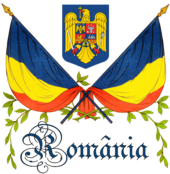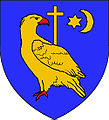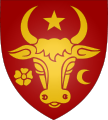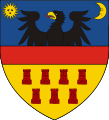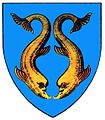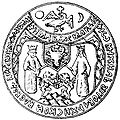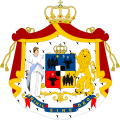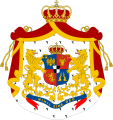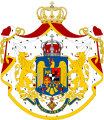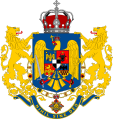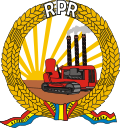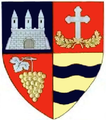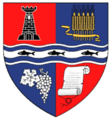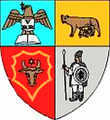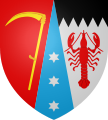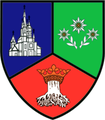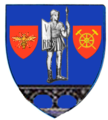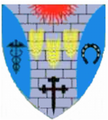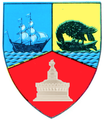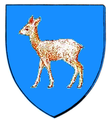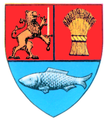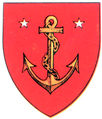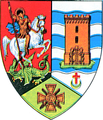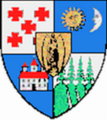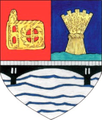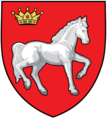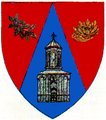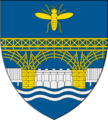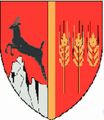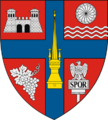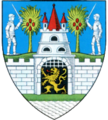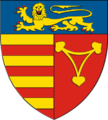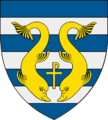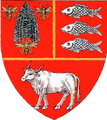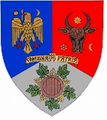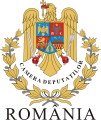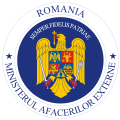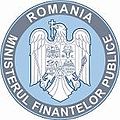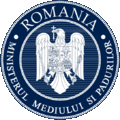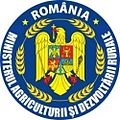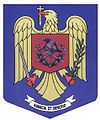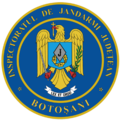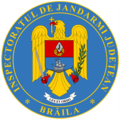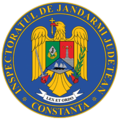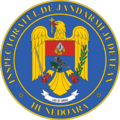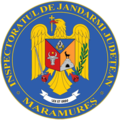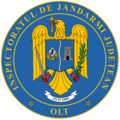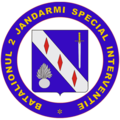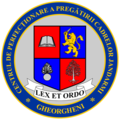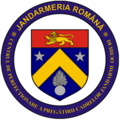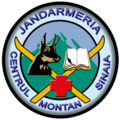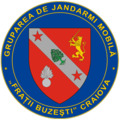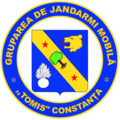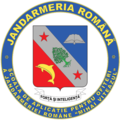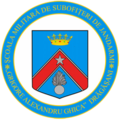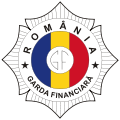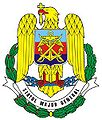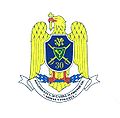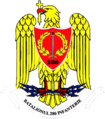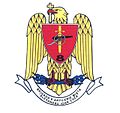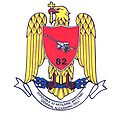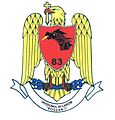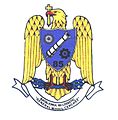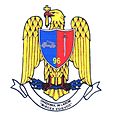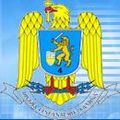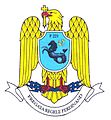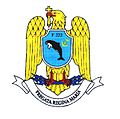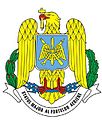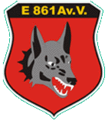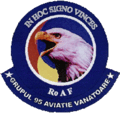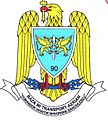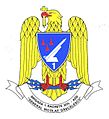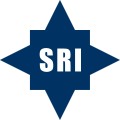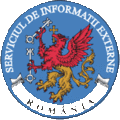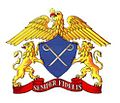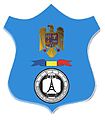- Romanian heraldry
-
This article is part of
Symbols of Romania seriesFlag of Romania · (history) · (list) Coat of arms of Romania Romanian Anthem Romanian heraldry Orders, decorations and medals Postage stamps of Romania Romanian leu Symbols of Romanian Royalty Symbols of Romania The armiger in Romania is the Government. It exercizes this right with the mandatory advice of the National Committee of Heraldry, Genealogy and Sigillography (Romanian: Comisia Naţională de Heraldică, Genealogie şi Sigilografie), the sole authorized body to approve coats of arms. This Committee is subordinated to the Romanian Academy. All the coats of arms of all the Romanian institutions must be approved by the National Committee of Heraldry, Genealogy and Sigillography. There are two big exceptions from this rule: coats of arms of the military (Romanian Armed Forces) are subject to the Ministry of National Defense Heraldric Committee, and the law enforcement institutions (Police, Firefighters, Gendarmerie, etc.) are subject to the Ministry of Administration and Interior Heraldric Committee. The latter two committees may share members with the National Committee of Heraldry, Genealogy and Sigillography.
Contents
Coat of arms of Romania
Historical principalities
-
The black eagle and seven castles, the coat of arms of Transylvania since the middle of the 18th century
-
The bridge of Apollodorus of Damascus, the coat of arms of Banat
-
The brown bear of Maramureş
Principality of Romania
1862 - 1866
After the election of Alexandru Ioan Cuza as Domnitor of Wallachia and of Moldavia, the heraldic symbols of the two countries were united to form the coat of arms of the new state, called, since 1862, Romania. The idea was not new: most of the Phanariotes used the united symbols in their personal coat of arms to express the fact that they ruled in both countries.
Until 1866, there was no official design of the coat of arms, although painter Carol Popp de Szathmary drew a few models.
1866 - 1878
After 10 May 1866 (when Carol I came to Romania), and the Constitution of 1 June 1866, the coat of arms was established, maintaining the idea used in the previous coat of arms. It was not changed until 1878, the year that Romania gained its independence and became a Kingdom.
Kingdom of Romania
1872 - 1921
In 1872 the coat of arms was changed again, this time being added the heraldic symbols for Oltenia and Black Sea's coast. After 1881, the last symbol will represent Dobrudja. Also, through use, the coat of arms' aspect was changed a bit.
1922 - 1947
After World War I, Transylvania, Bessarabia, Banat, and Bukovina united with the Kingdom of Romania. As a result, the symbols representing the new territories were added to the coat of arms.
-
The Great Coat of Arms
Used by the Royal House, and on international documents (Ministry of Foreign Affairs -
The Middle Coat of Arms
Used by the Military outhorities (Ministry of War)
People's Republic of Romania
After 1948, the Communist authorities changed both the flag and the coat of arms. The coat of arms was rather an emblem, faithful to the Communist pattern: a landscape (depicting a rising sun, a tractor and an oil drill) surrounded by stocks of wheat tied together with a cloth in the colors of the national flag. Until 1966 there were three variants, the first being changed shortly after 1948 (the proclamation of the republic), and again changed in 1956 (a red star was added).
Socialist Republic of Romania
The final change of the communist emblem took place in 1966, when Romania ceased to be a People's Republic, and became a Socialist Republic, thus changing the reading of the cloth from R.P.R. to REPUBLICA SOCIALISTǍ ROMÂNIA.
Romania
1989 - 1992
Right after the fall of Nicolae Ceauşescu and the communist regime, the communist emblem was cut out of all flags, and removed from all official seals of the nation. Some flags had a hole (a symbol of the revolution), some become pure blue-yellow-red, as later officially readopted. In the place of the coat of arms, institutions' seals bore the name of the country: ROMANIA or ROMÂNIA depending on the technology available for each institution.
1992 - present
Main article: Coat of arms of RomaniaIn 1992 the Parliament of Romania adopted the current coat of arms, by merging two proposed models, both of them inspired by the coat of arms of the Kingdom of Romania.
-
The seal
Coat of arms of local authorities
Coat of arms of counties
Coat of arms of county seats
The main heraldic element that helps people to distinguish between a coat of arms of a county and the one of an urban entity (village, commune, city, town or municipality) is a mural crown on the top of the latter. The crown has an odd number of towers (one, three, five or seven), depending on the importance of the urban entity in the country or county.
Coat of arms of other central institutions
Parliament
The Parliament itself does not hold a coat of arms, as it does not function as a whole body. When a law is published in the Official Gazette of Romania, it is headed by the country coat of arms.
The two houses of Parliament issue documents that are not laws. These documents bear in the heading the coat of arms of the issuing house.
The coat of arms of the Senate of Romania reproduces the national coat of arms surrounded by two olive branches tied together with a cloth in the colors of the national flag. On the yellow section it reads SENAT, and on top of the coat of arms it reads ROMÂNIA.
The coat of arms of the Chamber of Deputies of Romania reproduces the eagle of the national coat of arms surrounded by two olive branches tied together with a golden cloth. Beneath the eagle it reads CAMERA DEPUTAŢILOR, and beneath the olive branches it reads ROMÂNIA.
Ministries
Former coats of arms
-

Former Ministry of European Integration
-

The coat of arms of The Minister of Justice used until 2007
-
The coat of arms of The Ministry of Administration and Interior used until 2008 (?)
Heraldry of the Minisrty of Administration and Interior
In 2008, the Ministry of Administration and Interior decided to allow the units of the Inspectorates in its structure to use coats of arms. this refers to the County Inspectorates of Police, County Inspectorates of the Gendarmerie, County Inspectorates of the Border Police, County Inspectorates of the General Inspectorate for Emergency Situations, Units and educational institutions of the Gendarmerie, Schools of the Police, central units and institutions of the Ministry of Administration and Interior. This coats of arms are introduced gradually, starting 2010.
Prior to this heraldric operation, the Inspectorates in the Ministry where already allowed to use their own coats of arms, used both at national and local level.
The coats of arms of all the institutions of the Ministry are eleborated by the Ministry's Geraldric Commission, and not by the National Heraldry, Sealography, and Genealogy.
Police heraldry
Gendarmerie heraldry
-
Centre for Gendarmes Employees Training Gheorgheni
-
Sinaia Mountain Centre
-
Bucharest General Direcotrate for Gendarmes
-
Gendarmerie Mobile Group "Fraţii Buzeşti" Craiova
-
Gendarmerie Mobile Group "Matei Basarab" Ploiești
-
Gendarmerie Mobile Group "Tomis" Constanța
-
"Grigore Alexandru Ghica" Military School for Gendarmerie Under-Officers Drăgăşani
-
Military School for Gendarmerie Under-Officers Fălticeni
Other law enforcement authorities
Heraldry of the Romanian Armed Forces
Since the 18th century, the symbol of the Romanian Army is a golden crossed aquila, with red claws and beak, standing on zeus's thunderbolt. All the military coats of arms are created starting with this main element. The difference in rank of the military unit (central offices, batallion, regiment, etc.) is made by the shield shape.
The coats of arms of all the institutions of the Ministry are eleborated by the Ministry's Geraldric Commission, and not by the National Heraldry, Sealography, and Genealogy.
Secret services
References
Other Wikipedia pages
External links
- Romanian Personal Heraldry by Tudor-Radu Tiron
This article is part of the Romanian heraldry series National 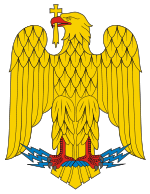
Historical provinces Wallachia • Moldavia • Northern Dobruja • Transylvania • Oltenia • BanatCounties Alba • Arad • Argeş • Bacău • Bihor • Bistriţa Năsăud • Botoşani • Braşov • Brăila • Buzău • Caraş-Severin • Călăraşi • Cluj • Constanţa • Covasna • Dâmboviţa • Dolj • Galaţi • Giurgiu • Harghita • Hunedoara • Ialomiţa • Iaşi • Ilfov • Maramureş • Mehedinţi • Mureş • Neamţ • Olt • Prahova • Sălaj • Satu Mare • Sibiu • Suceava • Teleorman • Timiş • Tulcea • Vaslui • Vâlcea • VranceaCounty Capitals
(Municipalities, Cities, Communes)Alba-Iulia • Alexandria • Arad • Bacău • Baia Mare • Bistriţa • Botoşani • Braşov • Brăila • Bucharest • Buftea • Buzău • Călăraşi • Constanţa • Craiova • Cluj-Napoca • Deva • Drobeta-Turnu Severin • Focşani • Galaţi • Giurgiu • Iaşi • Miercurea-Ciuc • Oradea • Piatra Neamţ • Piteşti • Ploieşti • Râmnicu Vâlcea • Reşiţa • Satu Mare • Sfântu Gheorghe • Sibiu • Slatina • Slobozia • Suceava • Târgovişte • Târgu Jiu • Târgu Mureş • Timişoara • Tulcea • Vaslui • ZalăuMinistries Other institutions Heraldry by country Albania • Andorra • Armenia • Australia • Austria • Azerbaijan • Belarus • Belgium • Bosnia and Herzegovina • Brazil • Bulgaria • Canada • Croatia • Cyprus • Czech Republic • Denmark • Estonia • Finland • France • Frisia • Georgia • Germany • Greece • Hungary • Iceland • Ireland • Italy • Japan • Kazakhstan • Latvia • Liechtenstein • Lithuania • Luxembourg • Republic of Macedonia • Malta • Mexico • Moldova • Monaco • Montenegro • Netherlands • Norway • Poland • Portugal • Romania • Russia • San Marino • Serbia • Slovakia • Slovenia • South Africa • Spain • Sweden • Switzerland • Turkey • Ukraine • United Kingdom (England • Scotland • Wales) • United States • Vatican City
Categories:- Heraldry by country
- Romanian heraldry
Wikimedia Foundation. 2010.

